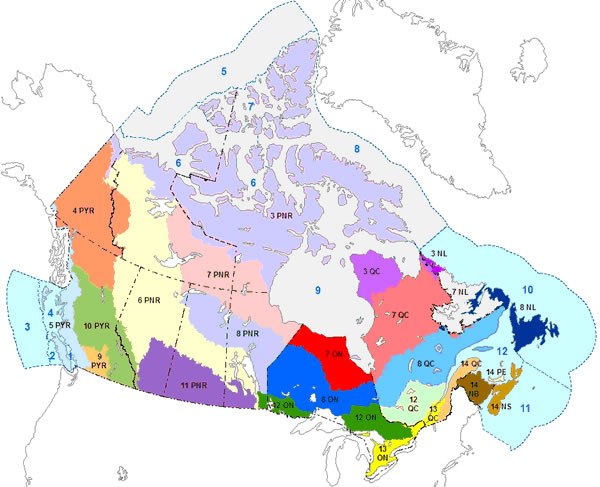Bird Conservation Regions and strategies
In response to concerns over declining populations of many species of once common birds, Canada, Mexico and the United States formed the North American Bird Conservation Initiative (NABCI) in 1999.
In order to plan, implement and evaluate conservation actions across the whole of North America, NABCI partners from the United States, Mexico, and Canada developed a common, ecologically based set of 'ecoregions' appropriate to birds throughout North America. For integrated bird conservation purposes in North America, Bird Conservation Regions (BCRs) function as the primary units within which biological planning is undertaken.
Through NABCI, Canada is committed to developing bird conservation strategies. These integrated, all-species ecoregional bird conservation strategies will provide a clear set of conservation objectives for birds of conservation concern across the country, developed according to a standard protocol. Conservation priorities and recommended actions from the BCR Strategies will be used as the biological basis to develop guidelines and beneficial management practices that support compliance with the Migratory Birds Convention Act, 1994. The BCR strategies will assist Environment and Climate Change Canada in fulfilling its mandate to manage migratory bird populations.
Map of 12 Bird Conservation Regions in Canada
There are 12 BCRs in Canada, several of which are divided into sub-regions. In all, 25 Canadian BCR Strategies have been prepared. For BCR names, descriptions and the completed BCR Strategies themselves, click on a BCR on the map.

Text Description for the Map
The map shows all of Canada, with Alaska, Greenland and the northern portion of the United States also appearing. Each of the 12 Canadian BCRs are displayed differently and indicating individual subregions (e.g. 3 PNR for the portion of BCR 3 in Prairie and Northern Region, 3 QC for the portion of this same BCR in Quebec Region). Individual BCR subregions are labelled on the map. BCRs 4, 5, 9 and 10 are mostly contained within Pacific and Yukon Region; BCRs 6 and 11 are mostly contained within Prairie and Northern Region; BCRs 3, 7 and 8 stretch across the northern parts of Prairie and Northern, Ontario, Quebec, and Atlantic Regions (though BCR 3 does not extend south into Ontario); BCRs 12 and 13 mainly cover central and southern parts of Ontario and Quebec (respectively); and BCR 14 covers part of eastern Quebec and all the Maritime provinces in Atlantic Region. In addition, Marine Biogeographic Units are visible along the coasts.
Regions
- Region 3 - Arctic Plains and Mountains
- Region 4 - Northwestern Interior Forest
- Region 5 - Northern Pacific Rainforest
- Region 6 - Boreal Taiga Plains
- Region 7 - Taiga Shield and Hudson Plains
- Region 8 - Boreal Softwood Shield
- Region 9 - Great Basin
- Region 10 - Northern Rockies
- Region 11 - Prairie Potholes
- Region 12 - Boreal Hardwood Transition
- Region 13 - Lower Great Lakes/St. Lawrence Plain
- Region 14 - Atlantic Northern Forests
The primary aims of BCR Strategies are to present Environment and Climate Change Canada’s priorities with respect to migratory bird conservation, and to provide a comprehensive overview of the conservation needs of bird populations to practitioners who may then undertake activities that promote bird conservation in Canada and internationally.
To achieve these aims, BCR Strategies provide landscape level information on 6 main elements of conservation including priority bird species (Element 1) and their habitat associations (Element 2), population objectives (Element 3), threats faced by priority species (Element 4), conservation objectives (Element 5) and proposed conservation actions (Element 6) to help reach the objectives. The information in the strategies is standardized across regions, integrated across species and follows widely accepted assessment methods.
Users from all levels of government, aboriginal communities, the private sector, academia, non-governmental organization (NGO)s and citizens will benefit from the information. BCR Strategies can be used in many different ways depending on the needs of the user, who may focus on one or more of the elements of the strategy.
For more detailed information on the scope, development and use of BCR Strategies, visit the Background Information Section.